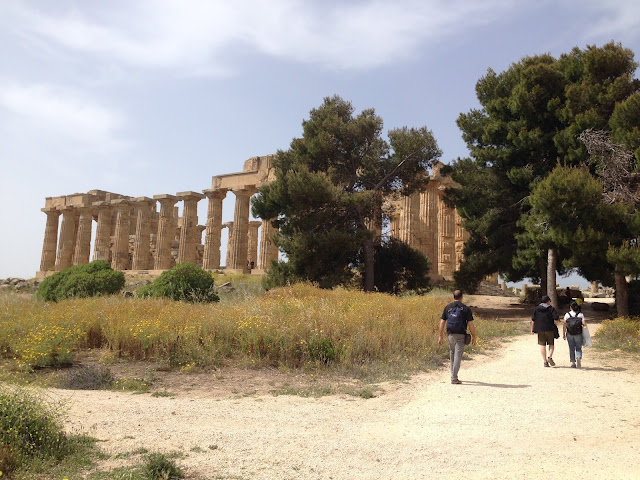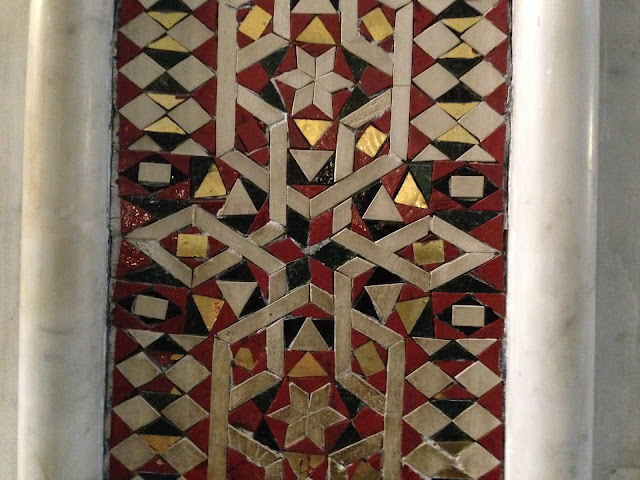Wrong! This gigantic pile of rocks and weeds is an entire Greek city.
And no-one can do weeds as well as the Sicilians.
The whole site was originally cleared of vegetation. Access roads, walking paths and a museum were built around 1960 when reconstruction of the Heraion temple (above) began. Little weeding has been done since.
The modern rediscovery of the remains of Heraion date back to 1823 when two young British archeologists found the famous sculpted friezes amongst the completely overgrown ruins.
It took until the 1950's to get a restoration project funded and underway. The temple was rebuilt from the fallen pieces found and identified on the site. Greek temples usually had a rich coating of colour, especially in the friezes atop the columns. Scraps remain in the museum.
There are three temples in a row on this part of the site, as you can see from the arial photo on the information board, taken in the 1950's when the site was clear of weedy growth. The reconstructed temple (Temple E) is at the bottom, the ruins of a very large structure (Temple G) at the top and a smaller temple (Temple F) in the middle. The museum on the left.
Few columns still stand at Temple F. This one remains a sentinel amidst fallen columns, lintels, friezes, steps and gigantic bases.
Looking back past Temple F to the reconstructed Temple E. You can clearly see the column that has fallen forward.
The heavy work of quarrying, cutting and moving columns, not on site and not on flat ground, but 11 kilometres away over the hills in Cuna.
Temple G, the last of the three was one of the largest in the Greek world, built in the mid 5th century BC. It was the oldest temple on this site.
Not much remains. Much would have been removed and used for other purposes in the past two centuries. The next photograph of me is taken amidst the (weeds and) the fallen column on the lower right of this picture.
A drawing depicting the city of Heraion from the sea, with another three temples and the buildings around the port. This part of the city is probably about 750 m from the first three temples we saw at the entrance to the archeological site.
This is how it looks today. You'd be forgiven for thinking that might be Inspector Montalbano's house on the water's edge. But no ... that comes later this week. Back to the temples .....
There is one temple with some columns standing, surrounded by many shops and dwellings.
The columns of this temple were originally reconstructed in 1925.
Major work was needed to strengthen the structure in 2013.
The area is roped off, understandably.
But what is still on the ground is pretty impressive.
The wind has whittled a larger hole between these stones.
The walls of shops and dwellings.
A final drawing of the city from the sea showing the natural cliffs with defensive walls above. Whereas the first drawing showed these three temples face on to the sea, this drawing shows their impressive side view and the dwellings and shops of the city behind.
Having been just about blown off the cliffs at Selinunte (it has been windy here for a week), we headed home along rural roads lined with red poppies.
Home for the last three days has been the lower floor of this "holiday house" owned by a family in Menfi with a ceramics business (tiles and bathroom fittings).
It is on high ground overlooking the sea. Absolutely spotless but without any heating, made worse by the wind.
Also without wifi and on two mornings, without hot water. Win some - loose some. Won the wifi with a Personal Wifi Hotspot from the Vodafone shop in Sciacca. Very reasonable - 59 euros for the modem, 10 euros for the SIM and 35 euros for 35G at 4G
Of course, we were in this particular residential location because of a restaurant.
Georgio Locatelli's favourite called 'da Vittorio' on the rocky beach at Porto Palo.
Two nights of fabulous seafood, fish and pasta cooked by Vittorio himself. The restaurant may look empty but half an hour later (about 9pm) was three quarters full on a Monday night.
A portrait of a happy man studying the wine list.
Next - blown along to the UNESCO World Heritage site at Agrigento.



















































